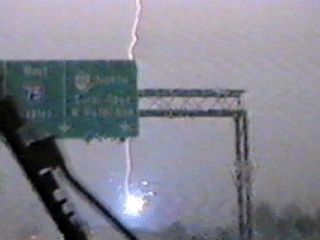Good day all,
I have been looking through some video frame grabs as well. I found these two frames, taken only 1/10 second apart. The point of the next two frames is crucial - If you are grabbing from video, at what point in the lightning bolts "life" are you grabbing?
Bolts of lightning do not instantly reach 50,000 degrees F, but do it very quickly. It is not too fast for a video camera's shutter, and something taking 1/10 of a second to heat from 65 degrees F to 60,000 degrees F can be captured by 3 video frames! Say we look at one of those first frames, when the bolt was 15,000 degrees F (it will not be white / bluish, it should be yellowish or green, according to the same temperature model used by stars).
The bolt above was JUST when it was striking (about 100 feet away) in a FL storm in April 1997. The bolt has not "heated up" yet and appears yellow to green.
The above picture, taken as the bolt was hottest, shows the more familiar "bluish" white color.
Note: Pictures shot with a Sony TRV-110 D8 camcorder in program AE mode. Except for resizing to 320x240, the pictures are un-re-touched. The quality is affected / distorted due to extremely heavy rains on the windhield. Never the less, the pictures clearly show what the colors you guys are talking about.
I am not sure about this one. I am not sure if it a lense artifact or not, but the "yellow" bolt coming off the front of my truck looks strange (leader feed?). This was in FL in July 1996, same camera equipment. I did get a strong "electrical" smell in my truck as well (ozone?)
The same bolt (the main one) taking out a power transformer about 100 yards away.




